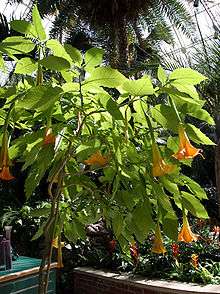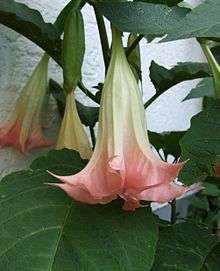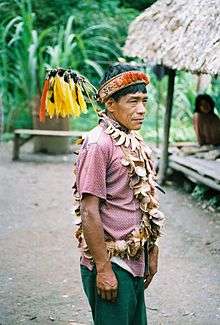Brugmansia
| Brugmansia | |
|---|---|
 | |
| Brugmansia 'Feingold' | |
| Scientific classification | |
| Kingdom: | Plantae |
| (unranked): | Angiosperms |
| (unranked): | Eudicots |
| (unranked): | Asterids |
| Order: | Solanales |
| Family: | Solanaceae |
| Subfamily: | Solanoideae |
| Tribe: | Datureae |
| Genus: | Brugmansia Pers. |
| Species | |
|
See text | |
| Synonyms | |
|
Methysticodendron R.E.Schult. | |
Brugmansia is a genus of seven species of flowering plants in the family Solanaceae. They are woody trees or shrubs, with pendulous flowers, and have no spines on their fruit. Their large, fragrant flowers give them their common name of angel's trumpets, a name sometimes used for the closely related genus Datura. (Datura differs from Brugmansia in that they are herbaceous bushes, with erect rather than pendulous flowers - and most have spines on their fruit).
Like many ornamental plants, all parts of Brugmansia can be toxic.[2] All seven species are listed as Extinct in the Wild by the IUCN Red List, although they still exist wild in other areas as an introduced species.[3]
Description
Brugmansia are large shrubs or small trees, with semi-woody, often many-branched trunks. They can reach heights of 3–11 m (10–36 ft). The leaves are alternately arranged along the stems, generally large, 10–30 cm (4–12 in) long and 4–18 cm (2–7 in) across, with an entire or coarsely toothed margin, and are often covered with fine hairs. The name "angel's trumpet" refers to the large, pendulous, trumpet-shaped flowers, 14–50 cm (6–20 in) long and 10–35 cm (4–14 in) across at the opening. They come in shades of white, yellow, pink, orange, green, or red. Most have a strong, pleasing fragrance that is most noticeable in the evening. Flowers may be single, double, or more.
Distribution and habitat
Brugmansia are native to tropical regions of South America, along the Andes from Venezuela to northern Chile, and also in south-eastern Brazil.[3] They are grown as ornamental container plants worldwide, and have become naturalized in isolated tropical areas around the globe, including within North America, Africa, Australia, and Asia.[4][5][6][7]
Ecology
Most Brugmansia are fragrant in the evenings to attract pollinating moths.[8] One species lacking scent, the red-flowered Brugmansia sanguinea, is pollinated by long-billed hummingbirds.[3] Brugmansia have two main stages to their life cycle. In the initial vegetative stage the young seedling grows straight up on usually a single stalk, until it reaches its first main fork at 80–150 cm (2.6–4.9 ft) high. It will not flower until after it has reached this fork, and then only on new growth above the fork. Cuttings taken from the lower vegetative region must also grow to a similar height before flowering, but cuttings from the upper flowering region will often flower at a very low height.[3]
One interesting example of plant/animal interaction involves the butterfly Placidula euryanassa, which uses Brugmansia suaveolens as one of its main larval foods. It has been shown that these can sequester the plant's tropane alkaloids and store them through the pupal stage on to the adult butterfly, where they are then used as a defense mechanism, making themselves less palatable to vertebrate predators.[9]
Taxonomy

Linnaeus first classified these plants as part of Datura with his 1753 description of Datura arborea. Then in 1805, C. H. Persoon transferred them into a separate genus, Brugmansia, named for Dutch naturalist Sebald Justinus Brugmans.[3] For another 168 years, various authors placed them back and forth between the genera of Brugmansia and Datura, until in 1973, with his detailed comparison of morphological differences, T.E. Lockwood settled them as separate genera, where they have stayed unchallenged since.[10]
Currently, there are 7 recognized species:[11]
- Brugmansia arborea (L.) Sweet (Andes - Ecuador to northern Chile)
- Brugmansia aurea Lagerh. (Andes - Venezuela to Ecuador)
- Brugmansia insignis (Barb.Rodr.) Lockwood ex R.E. R.E.Schult. (Eastern Andes foothills - Colombia to Bolivia and occasionally Brazil)
- Brugmansia sanguinea (Ruiz & Pav.) D.Don (Andes - Colombia to northern Chile)
- Brugmansia suaveolens (Willd.) Sweet (Southeast Brazil)
- Brugmansia versicolor Lagerh. (Ecuador)
- Brugmansia vulcanicola (A.S.Barclay) R.E.Schult.. (Andes - Colombia to Ecuador)
These species are then divided into two natural, genetically isolated groups.[12] Brugmansia section Brugmansia (the warm-growing group) includes the species aurea, insignis, sauveolens, and versicolor. Brugmansia section Sphaerocarpium (the cold group) includes the species arborea, sanguinea, and vulcanicola.[11]
Two of these species were challenged by Lockwood in his 1973 doctoral thesis.[13] First, Brugmansia vulcanicola was said to be a subspecies of B. sanguinea, but this was refuted by Lockwood's former mentor, R. E. Schultes in 1977.[14] Second, Lockwood proposed that the species B. insignis was instead a hybrid of the combination (B. suaveolens x B. versicolor) x B. suaveolens. This was later disproved by crossbreeding experiments done by the Preissels, published in 1997.[3]
Uses
Brugmansia are most often grown today as flowering ornamental plants.
In modern medicine, important alkaloids such as scopolamine, hyoscyamine, and atropine, found in Brugmansia and other related members of Solanaceae, have proven medical value for their spasmolytic, anti-asthmatic, anticholinergic, narcotic and anesthetic properties, although many of these alkaloids, or their equivalents, are now artificially synthesized.[15]
Brugmansia have also traditionally been used in many South American indigenous cultures in medical preparations and as an entheogen in religious or spiritual ceremonies.[16] Medicinally, they have mostly been used externally as part of a poultice, tincture, ointment, or where the leaves are directly applied transdermally to the skin. Traditional external uses have included the treating of aches and pains, dermatitis, orchitis, arthritis, rheumatism, headaches, infections, and as an anti-inflammatory. They have been used internally much more rarely due to the inherent dangers of ingestion. Internal uses, in highly diluted preparations, and often as a portion of a larger mix, have included treatments for stomach and muscle ailments, as a decongestant, to induce vomiting, to expel worms and parasites, and as a sedative.[17][18][19][20]
Several South American cultures have used Brugmansia as a treatment for unruly children, that they might be admonished directly by their ancestors in the spirit world, and thereby become more compliant. Mixed with maize beer and tobacco leaves, it has been used to drug wives and slaves before they were buried alive with their dead lord.[17][21][22]
Toxicity
All parts of Brugmansia are potentially poisonous, with the seeds and leaves being especially dangerous.[19][23] Brugmansia are rich in scopolamine (hyoscine), hyoscyamine, and several other tropane alkaloids.[24] Effects of ingestion can include paralysis of smooth muscles, confusion, tachycardia, dry mouth, diarrhea, migraine headaches, visual and auditory hallucinations, mydriasis, rapid onset cycloplegia, and death.[25][26][27]
The hallucinogenic effects of Brugmansia were described in the journal Pathology as "terrifying rather than pleasurable".[28] The author Christina Pratt, in An Encyclopedia of Shamanism, says that "Brugmansia induces a powerful trance with violent and unpleasant effects, sickening after effects, and at times temporary insanity".[19] These hallucinations are often characterized by complete loss of awareness that one is hallucinating, disconnection from reality, and amnesia of the episode, such as one example reported in Psychiatry and Clinical Neuroscience of a young man who amputated his own penis and tongue after drinking only 1 cup of Brugmansia tea.[29] The Swiss naturalist and explorer Johann von Tschudi described the effects of Brugmansia ingestion on one individual in Peru:
Soon after drinking the Tonga, the man fell into a dull brooding, he stared vacantly at the ground, his mouth was closed firmly, almost convulsively and his nostrils were flared. Cold sweat covered his forehead. He was deathly pale. The jugular veins on his throat were swollen as large as a finger and he was wheezing as his chest rose and sank slowly. His arms hung down stiffly by his body. Then his eyes misted over and filled with huge tears and his lips twitched convulsively for a brief moment. His carotids were visibly beating, his respiration increased and his extremities twitched and shuddered of their own accord. This condition would have lasted about a quarter of an hour, then all these actions increased in intensity. His eyes were now dry but had become bright red and rolled about wildly in their sockets and all his facial muscles were horribly distorted. A thick white foam leaked out between his half open lips. The pulses on his forehead and throat were beating too fast to be counted. His breathing was short, extraordinarily fast and did not seem to lift the chest, which was visibly fibrillating. A mass of sticky sweat covered his whole body which continued to be shaken by the most dreadful convulsions. His limbs were hideously contorted. He alternated between murmuring quietly and incomprehensibly and uttering loud, heart-rending shrieks, howling dully and moaning and groaning.[3]
One municipality prohibits the purchase, sale, or cultivation of Brugmansia plants.[3][30]
In 1994 in Florida, 112 people were admitted to hospitals from ingesting Brugmansia.[31] The concentrations of alkaloids in all parts of the plant differ markedly. They even vary with the seasons and the level of hydration, so it is nearly impossible to determine a safe level of alkaloid exposure.[25]
Cultivation
Brugmansia are easily grown in a moist, fertile, well-drained soil, in sun to part shade, in frost-free climates. They begin to flower in mid to late spring in warm climates and continue into the fall, often continuing as late as early winter in warm conditions. In cool winters, outdoor plants need protection from frost, but the roots are hardier, and may resprout in late spring. The species from the higher elevations, in B. section Sphaerocarpium, prefer moderate temperatures and cool nights, and may not flower if temperatures are very hot. Most Brugmansia may be propagated easily by rooting 10–20 cm (4–8 in) cuttings taken from the end of a branch during the summer.
Several hybrids and numerous cultivars have been developed for use as ornamental plants. B. × candida is a hybrid between B. aurea and B. versicolor; B. × flava is a hybrid between B. arborea and B. sanguinea; and B. × cubensis[12] is a hybrid between B. suaveolens, B. versicolor, and B. aurea. There are cultivars producing double flowers, and some with variegated leaves. The cultivar B. × candida 'Grand Marnier' has gained the Royal Horticultural Society's Award of Garden Merit.[32]
.jpg) Brugmansia hybrid flower
Brugmansia hybrid flower Brugmansia suaveolens
Brugmansia suaveolens Brugmansia × candida, Mangonui, North Island, New Zealand
Brugmansia × candida, Mangonui, North Island, New Zealand Brugmansia vulcanicola flower
Brugmansia vulcanicola flower Brugmansia suaveolens flower
Brugmansia suaveolens flower Mounts Botanical Garden, West Palm Beach, Florida
Mounts Botanical Garden, West Palm Beach, Florida Brugmansia x candida, Berkeley, California, USA
Brugmansia x candida, Berkeley, California, USA
References
- ↑ "Genus: Brugmansia Pers.". Germplasm Resources Information Network. United States Department of Agriculture. 2009-09-01. Retrieved 2010-09-25.
- ↑ http://ucanr.edu/sites/poisonous_safe_plants/Toxic_Plants_by_Scientific_Name_685/
- 1 2 3 4 5 6 7 8 Preissel, U.; Preissel, H. G. (2002). Brugmansia and Datura: Angel's Trumpets and Thorn Apples. Buffalo, New York: Firefly Books. pp. 106–129. ISBN 1-55209-598-3.
- ↑ Newmark, W. D. (2002). Conserving biodiversity in East African forests: A study of the Eastern Arc Mountains. Springer. p. 107. ISBN 978-3-540-42429-1.
- ↑ D'Arcy, W. G. (1986). Solanaceae Biology and Systematics. Columbia University Press. p. 24. ISBN 978-0-231-05780-6.
- ↑ Kurniati, H.; et al. (November 2010). "Ecology, Distribution and Bio-acoustic of Amphibians in Degraded Habitat" (PDF). Retrieved December 5, 2011.
- ↑ Haridasan, K.; Roa, R. R. (1985). Forest Flora of Meghalaya Vol. II. Bishen Singh Mahendra Pal Singh. p. 646. LCCN 85904619.
- ↑ Barwick, M. (2004). Tropical and Subtropical Trees: An Encyclopedia. Timber Press. ISBN 978-0-88192-661-3.
- ↑ Eich, E. (2008). Solanaceae and Convolvulaceae - Secondary Metabolites. Springer. pp. 157–158. ISBN 978-3-540-74540-2.
- ↑ Lockwood, T. E. (1973). "Generic Recognition of Brugmansia" (PDF). Botanical Museum Leaflets. 23: 273–283.
- 1 2 Hay, A.; Gottschalk, M.; Holguín, A. (2012). Huanduj: Brugmansia. Royal Botanic Gardens Kew. ISBN 978-1-84246-477-9.
- 1 2 Shaw, J. M. H. (1999). "Nomenclature Notes on Brugmansia". The New Plantsman. Royal Horticultural Society. 6 (3): 148–151.
- ↑ Lockwood, T. E. (1973). A taxonomic revision of Brugmansia (Solanaceae). OCLC 38575671.
- ↑ Schultes, R. E.; Bright, A. (1977). "A Native Drawing of an Hallucinogenic Plant From Colombia" (PDF). Botanical Museum Leaflets. Cambridge, MA: Harvard University. 25 (6).
- ↑ Schultes, R. E. Ethnobotany and History of Brugmansia.
- ↑ Harner, Michael (1980). The Way of the Shaman. New York: Harper & Row. Check date values in:
|access-date=(help); - 1 2 de Feo, V. (2004). "The ritual use of Brugmansia species in traditional Andean medicine in Northern Peru" (PDF). Economic Botany. 58 (Supplement 1): S221–S229. doi:10.1663/0013-0001(2004)58[S221:TRUOBS]2.0.CO;2.
- ↑ Duke, J. A.; Martinez, R. V. (1994). Amazonian Ethnobotanical Dictionary. p. 33. ISBN 978-0-8493-3664-5.
- 1 2 3 Pratt, C. (2007). An Encyclopedia of Shamanism. 1. The Rosen Publishing Group. pp. 68–70. ISBN 978-1-4042-1140-7.
- ↑ Fuller, T. C.; McClintock, E. (1988). Poisonous plants of California. University of California Press. pp. 233–235. ISBN 978-0-520-05569-8.
- ↑ Schultes, R. E. (1980). The Botany and Chemistry of Hallucinogens. Cambridge, MA: Harvard University. p. 270. ISBN 978-0-398-03863-2.
- ↑ Royal Horticultural Society (Great Britain) (2004). The Garden. 2004: 557. Missing or empty
|title=(help) - ↑ Biology Digest. 18. Plexus. 1991. LCCN 75646463.
- ↑ Evans, W. C.; Lampard, J. F. (1972). "Alkaloids of Datura suaveolens". Phytochemistry. 11 (11): 3293–3298. doi:10.1016/S0031-9422(00)86392-X.
- 1 2 van der Donck, I.; Mulliez, E.; Blanckaert, J. (2004). "Angel's Trumpet (Brugmansia arborea) and mydriasis in a child - A case report". Bulletin de la Societe Belge d'Ophtalmologie. 2004 (292): 53–56. ISSN 0081-0746. PMID 15253491.
- ↑ Wagstaff, D. J. (2008). International poisonous plants checklist: an evidence-based reference. CRC Press. p. 69. ISBN 978-1-4200-6252-6.
- ↑ Greenburg, M. I. (2006). Disaster!: A Compendium of Terrorist, Natural and Man-Made Catastrophes. p. 84. ISBN 978-0-7637-3989-8.
- ↑ Hayman, J. (1985). "Datura Poisoning-the Angel's Trumpet". Pathology. 17 (3): 465–466. doi:10.3109/00313028509105502. PMID 4069765.
- ↑ Marneros, A.; Gutmann, P.; Uhlmann, F. (2006). "Self-amputation of penis and tongue after use of Angel's Trumpet" (PDF). European Archives of Psychiatry and Clinical Neuroscience. 256 (7): 458–459. doi:10.1007/s00406-006-0666-2. PMID 16783491.
- ↑ "CODE, CITY OF MAITLAND, FLORIDA" (PDF). March 27, 2000. Retrieved December 20, 2011.
- ↑ Roberts, M. F.; Wink, M. (1998). Alkaloids: Biochemistry, Ecology, and Medicinal Applications. Springer. p. 28. ISBN 978-0-306-45465-3.
- ↑ "RHS Plant Selector - Brugmansia × candida 'Grand Marnier'". Retrieved 18 June 2013.
Further reading
- Hay, A., M. Gottschalk & A. Holguín (2012). Huanduj: Brugmansia English text, lots of diagrams and illustrations. ISBN 978-1-84246-477-9
- Gottschalk, Monika (2000). Engelstrompeten (German with English translation booklet). BLV Verlagsgesellschaft mbH. ISBN 978-3-405-15760-9
- Geit, Lars and Birgitta. Änglatrumpeter och spikklubbor Norwegian text but photo rich. Small coffee-table book. ISBN 978-91-534-2511-3
External links
| Wikimedia Commons has media related to Brugmansia. |
| Wikispecies has information related to: Brugmansia |
- ICRA plant registration for Brugmansia cultivar names
- Brugmansia discussion hobbyist group
- Detailed cultural information
- Langenbuscher Garten in Remscheid, Germany
- Brugmansia Vault – Erowid
